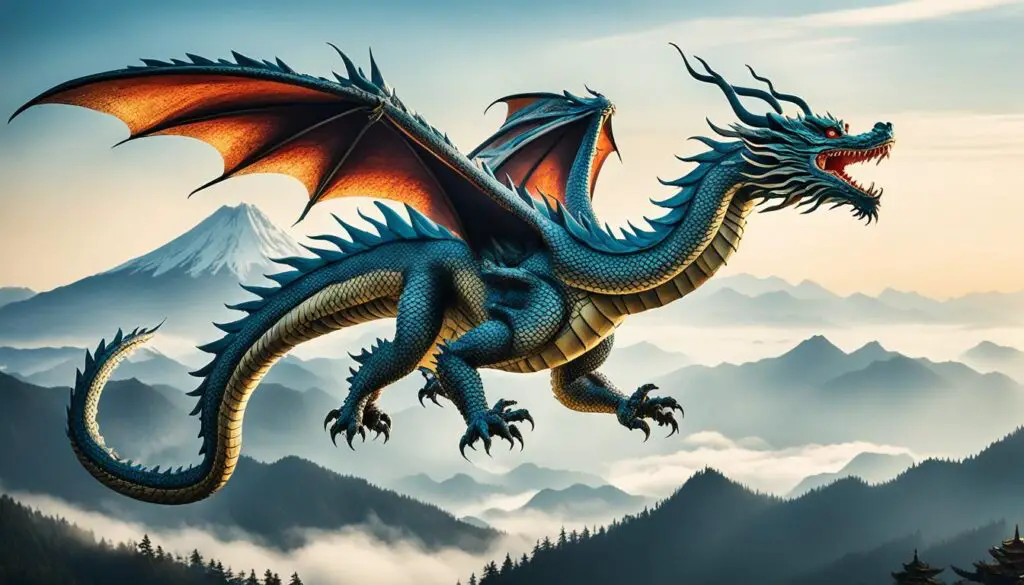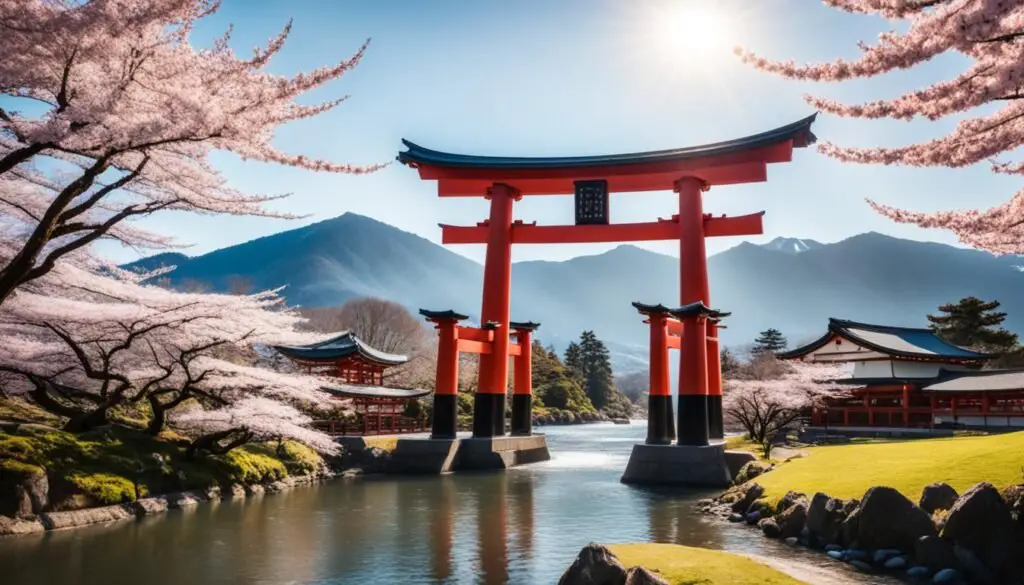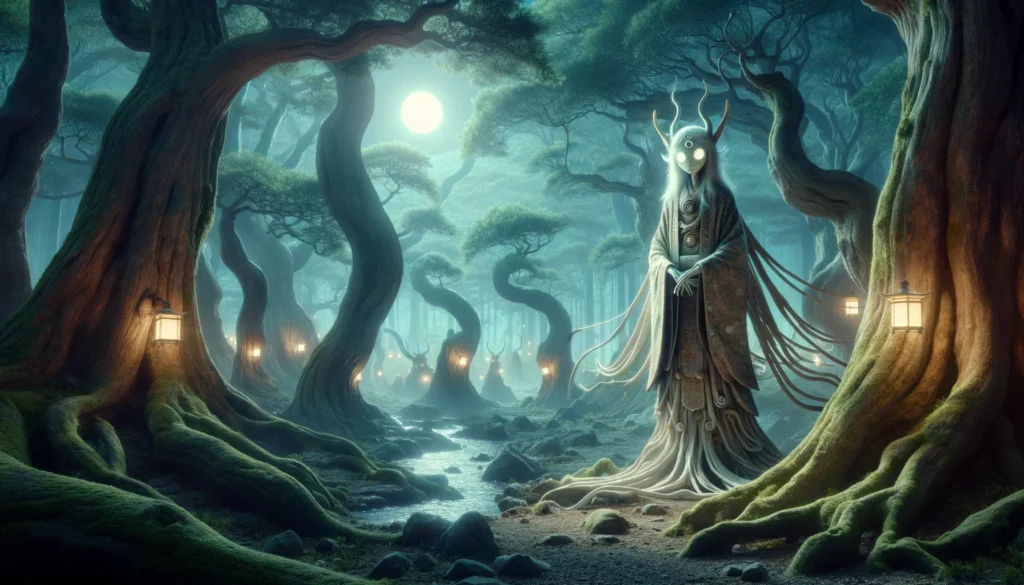Welcome to our in-depth exploration of Japanese mythology, where we unravel the secrets and delve into the captivating world of dragons.
Yes, dragons play a significant role in Japanese mythology, where they are known as “ryū” or “tatsu.” These mythological creatures often possess magical qualities, are associated with water bodies like seas, rivers, and lakes, and are considered to be powerful and wise. Japanese dragons are typically seen as benevolent beings, in contrast to some Western myths where dragons are often depicted as malevolent.
From their origins to their symbolic meanings, join us on a journey through history as we uncover the enchanting presence of dragons in Japanese mythology.
Key Takeaways:
- Dragons hold great cultural significance in Japanese mythology.
- They have various symbolic meanings and are closely tied to power and good fortune.
- Japanese dragons have their origins in a blend of historical and cultural influences.
- There are different types of dragons in Japanese mythology, with the Ryū being the most prominent.
- Famous dragon stories in Japanese mythology include Yamata no Orochi and Toyotama-hime.
The Origins of Dragons in Japanese Culture
In this section, we will explore the historical and cultural influences that have shaped the origins of dragons in Japanese culture.
From their connections to Chinese and Korean beliefs to their significance in Shinto and Buddhism, we will uncover the factors that have contributed to the development of Japanese dragons.
Historical and Cultural Influences
The origins of dragons in Japanese culture can be traced back to their interactions with neighboring countries such as China and Korea.
The influence of Chinese dragon mythology played a significant role in shaping the perception and symbolism of dragons in Japan.
Chinese dragons were associated with power, wisdom, and good fortune, traits that were later adopted in Japanese dragon lore.
Furthermore, Buddhism and Shintoism, the dominant religions in Japan, also contributed to the development of Japanese dragon mythology.
In Buddhism, dragons were often depicted as protectors and guardians of sacred Buddhist sites.
On the other hand, in Shintoism, dragons were revered as water deities, symbolizing the power of nature and the cycle of life.
Over time, these historical and cultural influences intertwined, resulting in the unique portrayal and symbolism of dragons in Japanese mythology.
The Japanese dragons, known as “Ryū” in Japanese, are revered creatures that embody power, wisdom, and protection.
They are often portrayed as benevolent beings who bring good fortune and prosperity to those they encounter.
Next, we will delve deeper into the different types of dragons in Japanese mythology and explore their symbolic meanings and significance in Japanese culture.
Types of Dragons in Japanese Mythology
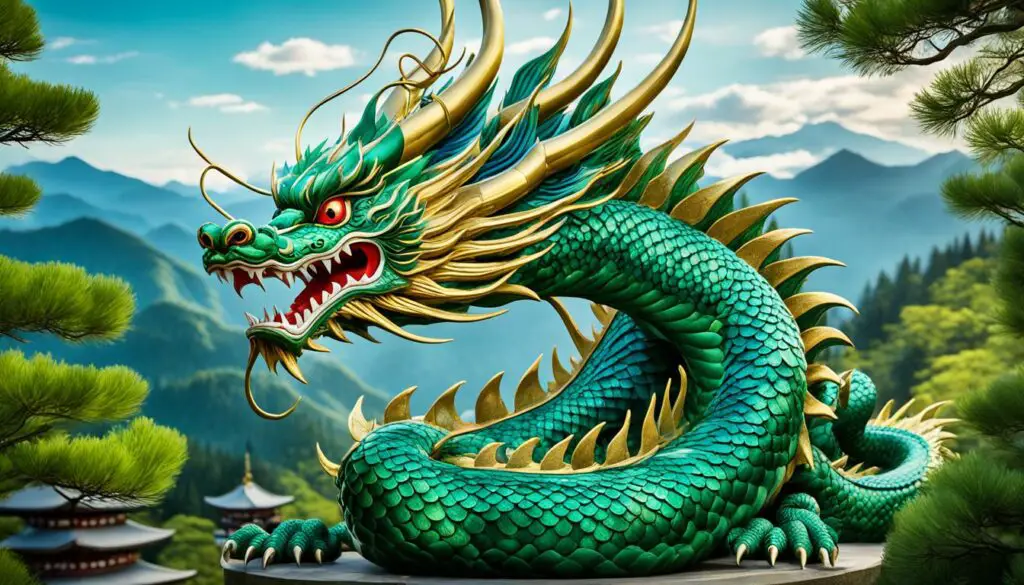
In Japanese mythology, dragons hold a prominent place, with various types of these majestic creatures appearing in folklore and cultural traditions.
Let’s explore the different types of dragons that exist in Japanese mythology, including the renowned Ryū (龍), also known as the Japanese dragon, which holds great symbolism in Japanese culture.
Ryū (龍) – The Japanese Dragon
The Ryū, or Japanese dragon, is a central figure in Japanese mythology, representing power, wisdom, and auspiciousness.
Unlike the Western concept of dragons as dangerous and malevolent creatures, the Japanese dragon is seen as benevolent and associated with good fortune.
Specific Dragons and Their Symbolisms
Aside from the Ryū, there are several specific dragons in Japanese mythology, each with its distinct symbolism. Here are a few notable examples:
-
Tatsu (龍) – Tatsu is a dragon revered in Japanese folklore, commonly associated with water and rainfall. It symbolizes fertility, growth, and the well-being of crops.
-
Fuku-ryū (福龍) – The Fuku-ryū, also known as the Fortune Dragon, is a dragon that embodies good luck and prosperity. It is often depicted with a ball, representing the presence of treasure.
-
Enryū (炎龍) – The Enryū, or Flame Dragon, represents the element of fire and its transformative power. It symbolizes passion, creativity, and spiritual enlightenment.
These dragons, along with many others, enrich the tapestry of Japanese mythology and contribute to the vibrant dragon symbolism within Japanese culture.
Famous Dragons and Their Stories
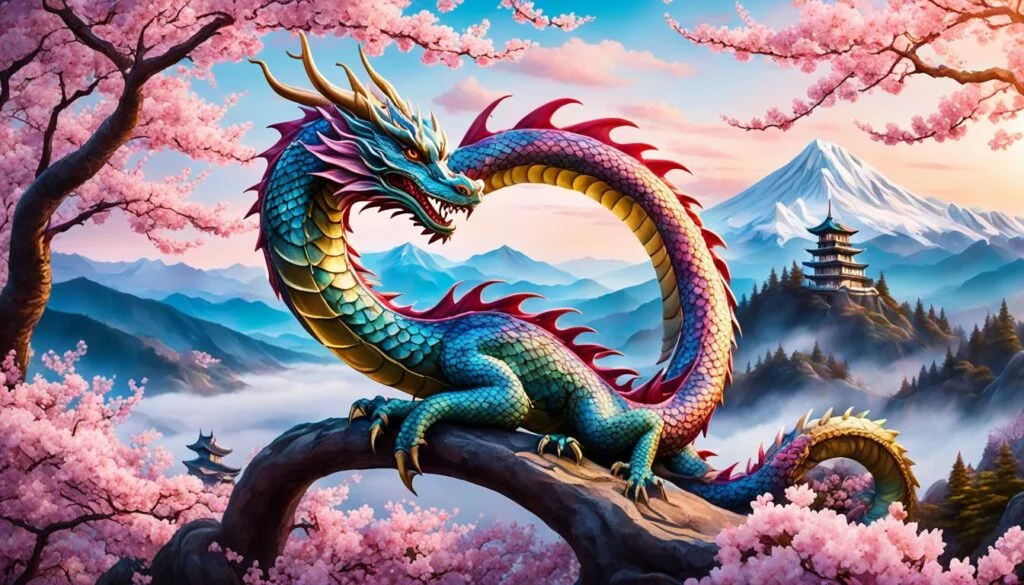
In this section, we will uncover the stories of famous dragons in Japanese mythology.
These captivating tales have been passed down through generations, captivating audiences with their fantastical narratives.
Let us explore two prominent dragons in Japanese folklore: Yamata no Orochi and Toyotama-hime and the sea dragon.
Yamata no Orochi – The Eight-Headed Dragon
One of the most famous Japanese dragons, Yamata no Orochi, is a fearsome creature depicted with eight heads and eight tails.
According to legend, Orochi terrorized Japan, demanding a sacrifice of the daughter of a local village chief each year.
However, a brave warrior named Susano-o intervened and vowed to slay the dragon.
With the help of clever strategy and divine aid, Susano-o managed to defeat Yamata no Orochi.
After its defeat, the warrior discovered a magical sword within one of Orochi’s tails, an artifact that would play a significant role in Japanese mythology.
The story of Yamata no Orochi highlights the courage and ingenuity of heroes who face formidable challenges.
It also showcases the belief in the power of divine intervention and the triumph of good over evil.
Toyotama-hime and the Sea Dragon
Another fascinating tale involves Toyotama-hime, a beautiful princess who was married to a prince from the sea dragon kingdom.
However, the princess eventually returned to the sea, revealing her true form as a dragon known as the “sea goddess.”
Toyotama-hime’s story intertwines love, sacrifice, and the connection between humans and mythical creatures.
It reflects the belief in the divine nature of dragons and their ability to shape the course of human lives.
Visually breathtaking, the image above captures the awe-inspiring presence of famous Japanese dragons that we encounter in their stories.
These dragon tales serve as a testament to the rich and vibrant mythological heritage of Japan, captivating audiences with their vivid imagery and timeless themes.
Each story holds cultural significance and contributes to the legacy of dragons in Japanese culture.
Symbolic Meanings of Dragons in Japanese Mythology
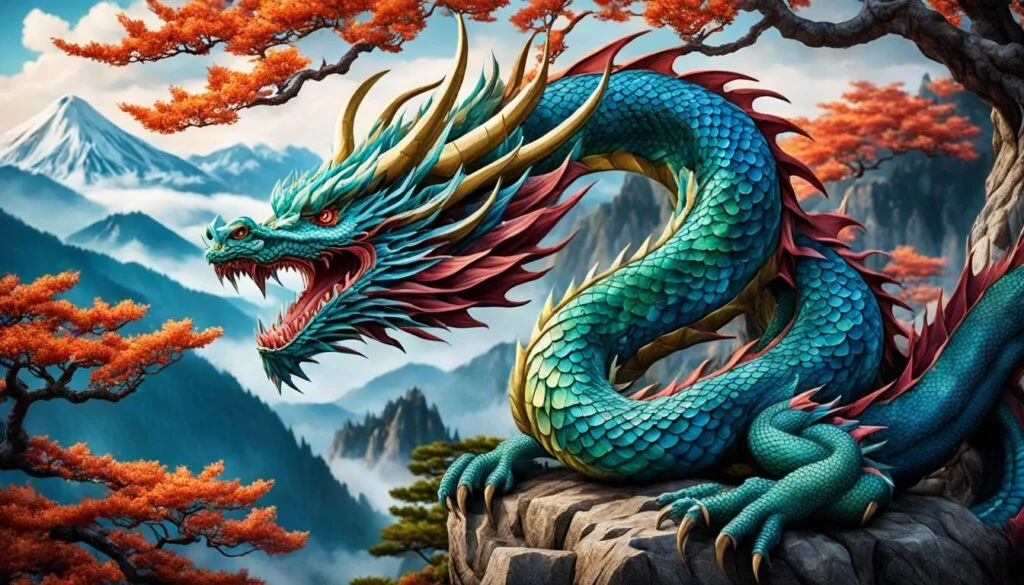
In Japanese mythology, dragons hold significant symbolic meanings that are deeply ingrained in the culture.
These mystical creatures are often associated with power and good fortune, as well as the concept of imperial authority. Let us explore the rich symbolism surrounding dragons in Japanese mythology.
Dragons as Symbols of Power and Good Fortune
Dragons in Japanese mythology are revered for their association with power. They are seen as mighty beings that possess immense strength, often depicted as rulers of the natural elements such as water, rain, and storms.
Their formidable presence symbolizes the strength and authority of those who wield their power wisely.
Beyond their association with power, dragons are also considered as bringers of good fortune.
They are believed to bring luck, prosperity, and success to those who come into contact with them.
As such, dragons are often depicted in Japanese art and as decorative motifs in homes and businesses to attract blessings and positive energy.
Dragons and Imperial Authority
In Japanese culture, dragons hold a special connection to imperial authority. They have long been associated with the emperor, symbolizing his sovereignty and the divine mandate to rule.
The dragon’s presence in imperial iconography and regalia signifies the emperor’s legitimacy and the unbroken lineage of imperial authority.
Furthermore, dragons are often featured in traditional imperial celebrations and rituals, further reinforcing their connection to imperial authority.
These majestic creatures serve as a visual representation of the emperor’s power and serve as a reminder of the significance of the imperial institution in Japanese society.
Exploring the Symbolism
Through their symbolism of power, good fortune, and imperial authority, dragons hold a revered place in Japanese mythology.
Their presence in art, festivals, and folklore reflects the enduring cultural significance of these mythical creatures in Japanese society.
Whether as protectors, bringers of luck, or symbols of authority, dragons continue to captivate the imagination and leave an indelible mark on Japanese culture.
Dragons in Japanese Art and Festivals
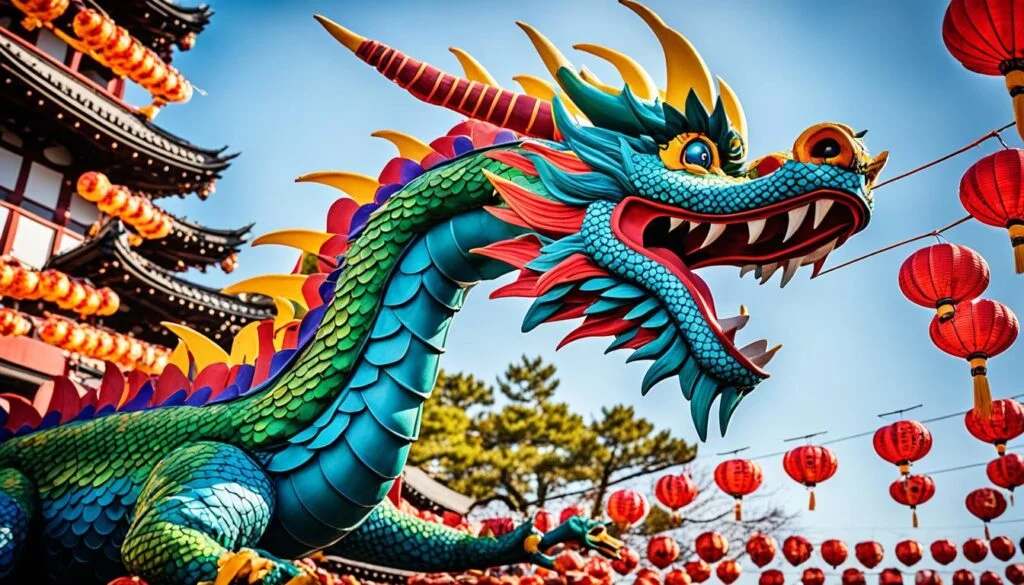
Depictions of Dragons in Japanese Art
Japanese art has a long-standing tradition of incorporating dragons into various forms and mediums.
These mythical creatures are often depicted in paintings, sculptures, and even traditional woodblock prints.
The depictions of dragons in Japanese art are known for their intricate details and vibrant colors, showcasing the awe-inspiring power and majestic presence of these legendary beings.
Dragons are commonly portrayed as serpentine creatures with scales, horns, and fierce expressions.
Their coiled bodies and flowing tails symbolize their dynamic and energetic nature, while their sharp claws and menacing gaze evoke a sense of strength and dominance.
Dragon Festivals and Celebrations
Dragon festivals and celebrations are an integral part of Japanese culture, providing a platform to honor and celebrate the significance of dragons.
These festivals are marked by vibrant parades, traditional performances, and cultural rituals that pay tribute to the mythical creatures.
The festivals often feature enormous dragon-shaped floats, which are carried through the streets amidst jubilant cheers and lively music.
People come together to witness the spectacle and revel in the festive atmosphere, immersing themselves in the rich traditions and symbolism associated with dragons.
These celebrations not only showcase the artistic prowess of the Japanese, but also serve as a reminder of the deep-rooted cultural traditions that dragons represent in Japanese society.
The Legacy of Dragons in Modern Japanese Media
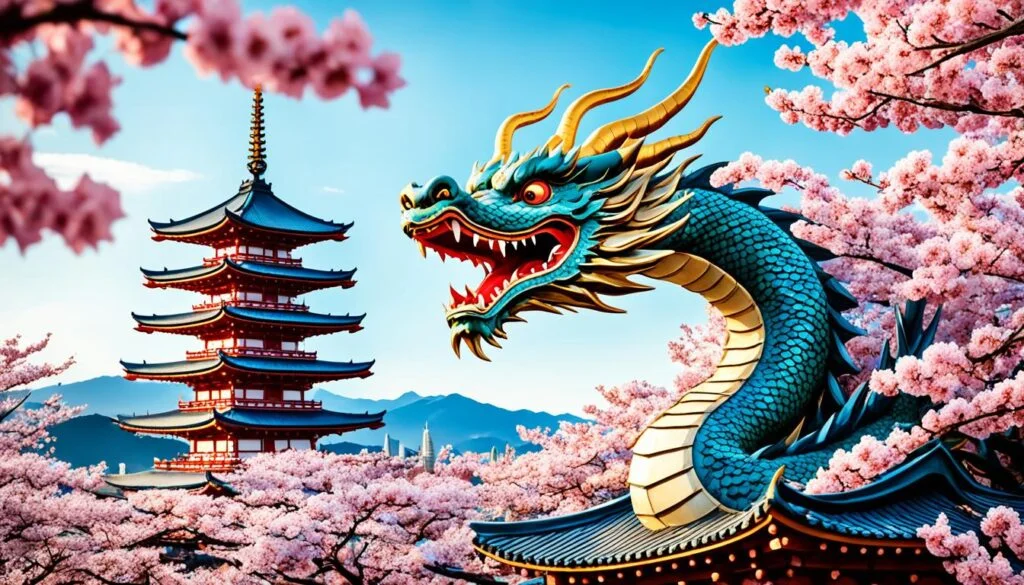
In modern Japanese media, dragons continue to captivate audiences through their presence in various forms of entertainment.
From anime and manga to literature and film, dragons have cemented their legacy in the realm of modern Japanese pop culture.
Dragons in Anime and Manga
Anime and manga enthusiasts are no strangers to the awe-inspiring dragons depicted in their favorite series.
These mythical creatures often take center stage, serving as both allies and adversaries to the protagonists.
Whether it’s the majestic dragon companions in “Fairy Tail” or the mystical Dragon Balls in “Dragon Ball,” dragons are woven into the intricate narratives, adding an element of excitement and wonder.
Dragons in Contemporary Literature and Film
Dragons have also been featured prominently in contemporary literature and film, showcasing their enduring appeal.
From novels like “Eragon” by Christopher Paolini, where a young boy bonds with a dragon, to movies like “How to Train Your Dragon,” where unlikely friendships form between humans and dragons, these stories continue to enchant readers and viewers alike.
Conclusion
In conclusion, our exploration of the presence of dragons in Japanese mythology has revealed the deep cultural significance and enduring legacy of these mythical creatures.
Throughout history, dragons have played a pivotal role in shaping Japanese culture, leaving a lasting impact on art, festivals, and even modern media.
The presence of dragons in Japanese mythology extends beyond mere folklore. These creatures hold symbolic meanings that resonate with the Japanese people.
Dragons are often associated with power and good fortune, representing the aspirations and values of the Japanese society.
From ancient legends of Yamata no Orochi, the fearsome eight-headed dragon, to contemporary portrayals in anime and manga, dragons continue to captivate the imagination of the Japanese people.
Their presence in literature, film, and other forms of media reinforces their cultural significance and ensures their lasting legacy in Japanese pop culture.
By understanding the presence of dragons in Japanese mythology, we gain a deeper appreciation for the rich traditions and beliefs that have shaped the country’s history.
The cultural significance and legacy of Japanese dragons are evident in their symbolism, art, and enduring popularity, reinforcing their status as iconic and beloved creatures in Japanese culture.
Frequently Asked Questions
Q: Did dragons exist in Japanese mythology?
A: Yes, dragons are a prominent part of Japanese mythology, known as “ryū” or “tatsu,” and are often depicted as water deities associated with rainfall, rivers, and seas.
Q: Is there a Japanese dragon god?
A: Yes, several Japanese dragon gods are revered, including Ryūjin or Ryōjin, the dragon god of the sea, who is believed to control the tides and rain.
Q: What is the Japanese version of dragon?
A: The Japanese version of dragons, known as “ryū” or “tatsu,” often resembles serpentine creatures with elongated bodies, small limbs, and are associated with water.
Q: What power do dragons have in Japanese mythology?
A: In Japanese mythology, dragons are believed to have powers over water, such as controlling rainfall, tides, and bodies of water. They are also thought to possess wisdom and longevity.
Q: Is Oni a dragon?
A: No, Oni are not dragons. They are demons or ogres in Japanese folklore known for their fearsome appearance and malevolent nature.
Q: What do dragons symbolize in Japan?
A: In Japan, dragons symbolize strength, wisdom, and the power to bring rain, making them guardians of water and agriculture.
Q: Who is the strongest dragon in Japanese mythology?
A: While “strongest” can be subjective, Ryūjin, the sea dragon god, is often considered one of the most powerful dragons in Japanese mythology due to his dominion over the seas and rain.
Q: What is the blue dragon in Japanese mythology?
A: The blue dragon, known as “Seiryū” in Japanese, is one of the Four Symbols of the Chinese constellations and represents the east and the spring season. It is a significant figure in Japanese mythology as well.
Q: What does ryū mean in Japan?
A: “Ryū” means “dragon” in Japanese and refers to the dragon creatures found in Japanese folklore, which are often associated with water.
Q: What do Japanese dragons look like?
A: Japanese dragons typically have long, serpentine bodies with clawed feet, are covered in scales, and can have various numbers of claws. They are often depicted with flowing manes and whiskers.
Q: Are dragons considered yokai?
A: Dragons in Japanese culture are not typically classified as yokai, which are usually lesser supernatural creatures or spirits. Dragons are often revered as deities or powerful spiritual entities.


